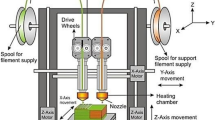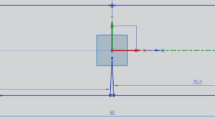Abstract
The application of fused filament fabrication (FFF) process has been growing fast in different fields of industries as a practical and cost-effective solution for prototyping and production of functional components. However, the fracture behavior of the printed specimens is a subject of research as there is a need for service reliability and predictable performance of components. In this paper, the effects of internal architecture in FFF process on mixed-mode I/II fracture of U-notched printed samples were experimentally and numerically investigated. The load carrying capacity of U-notched 3D printed parts were calculated using a combined J-integral criterion and equivalent material concept (EMC) to consider the elastic–plastic behavior of the material. The tensile and fracture specimens were printed by biodegradable polylactic acid (PLA) thermoplastic filaments under constant filling ratio and at different filling patterns, namely, 3D infill, hexagonal, linear and triangular. The experiments were performed to determine the transversely isotropic mechanical properties and the fracture loadings of the samples at different loading angles. A finite element model was developed to conduct the J-integral calculation for each sample based on transversely isotropic properties of printed samples and plane-stress analyses. Based on the results, the samples with 3D infill structure possessed the lowest strength, load carrying capacity and fracture toughness as compared with that of other filling patterns. In contrast, the triangular filling pattern incorporated the highest fracture toughness and load carrying capacity in samples produced by FFF technique.














Similar content being viewed by others
References
Gu GX, Takaffoli M, Hsieh AJ, Buehler MJ (2016) Biomimetic additive manufactured polymer composites for improved impact resistance. Extreme Mech Lett 9:317–323. https://doi.org/10.1016/j.eml.2016.09.006
Zolfagharian A, Kouzani AZ, Khoo SY, Moghadam AA, Gibson I, Kaynak A (2016) Evolution of 3D printed soft actuators. Sens Actuators A 250:258–272. https://doi.org/10.1016/j.sna.2016.09.028
Vyatskikh A, Kudo A, Delalande S, Greer JR (2018) Additive manufacturing of polymer-derived titania for one-step solar water purification. Mater Today Commun 15:288–293. https://doi.org/10.1016/j.mtcomm.2018.02.010
Haghiashtiani G, Habtour E, Park SH, Gardea F, McAlpine MC (2018) 3D printed electrically-driven soft actuators. Extreme Mech Lett 21:1–8. https://doi.org/10.1016/j.eml.2018.02.002
Khosravani MR, Reinicke T (2020) 3D-printed senosrs: current progress and future challenges. Sens Actuators A 306:111916. https://doi.org/10.1016/j.sna.2020.111916
Hamzah HH, Keattch O, Covill D, Patel BA (2018) The effects of printing orientation on the electrochemical behaviour of 3D printed acrylonitrile butadiene styrene (ABS)/carbon black electrodes. Sci Rep 8:9135. https://doi.org/10.1038/s41598-018-27188-5
Nagarajan V, Mohanty AK, Misra M (2016) Perspective on polylactic acid (PLA) based sustainable materials for durable applications: focus on toughness and heat resistance. ACS Sustain Chem Eng 4:2899–2916. https://doi.org/10.1021/acssuschemeng.6b00321
Ahn SH, Montero M, Odell D, Roundy S, Wright PK (2002) Anisotropic material properties of fused deposition modeling ABS. Rapid Prototyp J 8(4):248–257. https://doi.org/10.1108/13552540210441166
Bellini A, Güçeri S (2003) Mechanical characterization of parts fabricated using fused deposition modeling. Rapid Prototyp J 9(4):252–264. https://doi.org/10.1108/13552540310489631
Zou R, Xia Y, Liu S, Ping Hu, Hou W, Qingyuan Hu, Shan C (2016) Isotropic and anisotropic elasticity and yielding of 3D printed material. Composites B 99:506–513. https://doi.org/10.1016/j.compositesb.2016.06.009
Alaimo G, Marconi S, Costato L, Auricchio F (2017) Influence of meso-structure and chemical composition on FDM 3D-printed parts. Composites B 113:371–380. https://doi.org/10.1016/j.compositesb.2017.01.019
Torun AR, Dike AS, Yıldız EC, Sağlam İ, Choupani N (2021) Fracture characterization and modeling of Gyroid filled 3D printed PLA structures. Mater Testing 63(5):397–401. https://doi.org/10.1515/mt-2020-0068
Torun AR, Yıldız EC, Kaya ŞH, Choupani N (2020) Mixed-mode fracture behavior of 3D-printed PLA with zigzag filling. Green Mater 9(1):29–36. https://doi.org/10.1680/jgrma.20.00013
Abadi RH, Torun AR, Fard AMZ, Choupani N (2020) Fracture characteristics of mixed-mode toughness of dissimilar adherends (cohesive and interfacial fracture). J Adhes Sci Technol 34(6):599–615. https://doi.org/10.1080/01694243.2019.1674102
Boğa C (2021) Investigation of mechanical and fracture behavior of pure and carbon fiber reinforced ABS samples processed by fused filament fabrication process. Rapid Prototyp J. https://doi.org/10.1108/RPJ-11-2020-0296
Abolfazl Zahedi C, Kodsi FB (2019) Numerical predictions of U-notched sample failure based on a discrete energy argument. Theoret Appl Fract Mech 100:298–306. https://doi.org/10.1016/j.tafmec.2018.12.014
Khosravani MR, Zolfagharian A (2020) Fracture and load-carrying capacity of 3D-printed cracked components. Extreme Mech Lett 37:100692. https://doi.org/10.1016/j.eml.2020.100692
Vukasovic T, Vivanco JF, Celentano D, García-Herrera C (2019) Characterization of the mechanical response of thermoplastic parts fabricated with 3D printing. Int J Adv Manuf Technol 104:4207–4218. https://doi.org/10.1007/s00170-019-04194-z
Lanzillotti P, Gardan J, Makke A, Recho N (2019) Enhancement of fracture toughness under mixed mode loading of ABS specimens produced by 3D printing. Rapid Prototyp J 25(4):679–689. https://doi.org/10.1108/RPJ-09-2018-0247
Ghandriz R, Hart KR, Li J (2020) Extended finite element method (XFEM) modeling of fracture in additively manufactured polymers. Addit Manuf 31:100945. https://doi.org/10.1016/j.addma.2019.100945
Ameri B, Taheri-Behrooz F, Aliha MR (2020) Fracture loads prediction of the modified 3D-printed ABS specimens under mixed-mode I/II loading. Eng Fract Mech 235:107181. https://doi.org/10.1016/j.engfracmech.2020.107181
Khosravani MR (2018) Influence of defects on the performance of adhesively bonded sandwich joints. Key Eng Mater 789:45–50. https://doi.org/10.4028/www.scientific.net/KEM.789.45
Torabi AR, Berto F, Razavi MJ (2018) Tensile failure prediction of U-notched plates under moderate-scale and large-scale yielding regimes. Theoret Appl Fract Mech 97:434–439. https://doi.org/10.1016/j.tafmec.2017.07.009
Turner CE, Kolednik O (1994) A micro and macro approach to the energy dissipation rate model of stable ductile crack growth. Fatigue Fract Eng Mater Struct 17:1089–1107. https://doi.org/10.1111/j.1460-2695.1994.tb00837.x
Frank D, Remes H, Romanoff J (2013) J-integral-based approach to fatigue assessment of laser stake-welded T-joints. Int J Fatigue 47(2013):340–350. https://doi.org/10.1016/j.ijfatigue.2012.09.019
Torabi AR (2012) Estimation of tensile load-bearing capacity of ductile metallic materials weakened by a V-notch: the equivalent material concept. Mater Sci Eng A 536:249–255. https://doi.org/10.1016/j.msea.2012.01.007
Acknowledgements
This work was supported by Scientific Research Coordination Unit of Adana Alparslan Türkeş Science and Technology University with project number of 21103014.
Author information
Authors and Affiliations
Corresponding author
Ethics declarations
Conflict of interest
Submission of this paper implies that if accepted it will not be published elsewhere, in English or in any other language, and Springer publisher is granted with the exclusive, permanent, and unlimited right to reproduce, publish, distribute, and transmit this paper. The authors declare that there are no competing financial and/or non-financial interests that could undermine, or perceived to undermine, the objectivity, integrity and value of this article.
Additional information
Publisher's Note
Springer Nature remains neutral with regard to jurisdictional claims in published maps and institutional affiliations.
Rights and permissions
About this article
Cite this article
Seyedzavvar, M., Boğa, C. Investigation on the effects of printing pattern on the load carrying capacity of 3D printed U-notched samples. Meccanica 57, 1575–1590 (2022). https://doi.org/10.1007/s11012-022-01514-8
Received:
Accepted:
Published:
Issue Date:
DOI: https://doi.org/10.1007/s11012-022-01514-8




